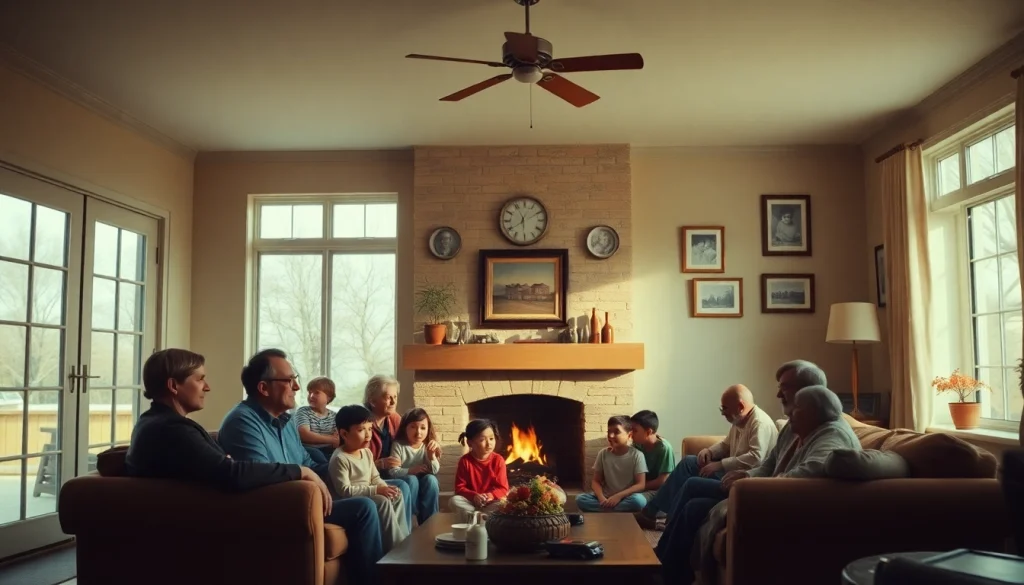Understanding the Theme of Here
The film Here epitomizes a poignant exploration of family, memory, and the spaces we inhabit across generations. Directed by Robert Zemeckis, who returns to the screen with a narrative echoing some of his past hits, “Here” takes viewers on an emotional journey through multiple decades, focusing on the lives of various families intertwined within a single home. It embodies a rich tapestry of human experiences that resonate deeply with viewers, illustrating how the past shapes our identity and relationships in the present.
What Makes Here Unique?
“Here” stands apart from typical family dramas through its innovative storytelling techniques and vibrant cinematography. The film’s unique approach lies in its nonlinear narrative structure, which allows audiences to experience vital moments from several families over time. This presentation not only highlights the interconnectedness of the lives affected by the physical space but also delves into the emotional resonance of each character’s journey. Through its cinematographic prowess, the film captures the essence of time, making the audience feel both nostalgia and the weight of familial legacies.
An Overview of the Plot
The narrative arc of “Here” revolves around multiple generations of families that inhabit the same house, showcasing their struggles, triumphs, and the environment that molds them. The story initiates in the early 1900s, setting a backdrop of socio-political changes that influence the characters’ lives. Key events are interspersed with historical highlights that reflect the evolving cultural landscape of America over the century. Alongside major events, the subtle transformations in the characters’ relationships and lifestyles provide depth, portraying the family unit as both a supporter and a source of conflict.
The Role of Family Dynamics in Here
Family is a central theme in “Here,” presenting both a haven and a battleground for its characters. The film keenly explores the complexities of familial bonds, depicting how love, resentment, sacrifice, and tradition play pivotal roles in shaping individual identities. It illustrates the cycles of patterns passed down from generation to generation, showing how past grievances can influence future perceptions. The emotional weight of familial expectations is poignantly highlighted through the characters’ dialogue and interactions, drawing viewers into the nuanced interplay of affection and obligation present in real-life family dynamics.
Character Analysis in Here
Main Characters and Their Journeys
“Here” boasts a rich ensemble cast that successfully embodies the complexities of human experiences. The principal characters, ranging from young children to elderly family members, each represent different facets of life and the myriad challenges it presents. Central to the story is a matriarch, whose memories serve as the film’s anchor. As her family grapples with change, her experiences provide wisdom and sometimes foresight regarding the future. The journeys undertaken by these characters reflect their struggles with love, identity, and belonging, encouraging the audience to reflect on their own relationships.
Supporting Characters and Their Impact
The supporting characters in “Here” enhance the depth of the story, each contributing unique perspectives that complement the main narrative. Friends, neighbors, and ancestors intertwine with the core family, illustrating the broader social connections that influence personal growth and familial interactions. These characters often serve as catalysts for change, sparking pivotal moments that lead to self-discovery or reconciliation. They provide a necessary contrast to the familial experience, accentuating themes of community and shared memories.
Character Development Throughout the Film
Character development is central to “Here,” with each individual portrayed as a dynamic entity capable of growth and change. Through trials and triumphs, characters evolve, often learning vital lessons about love, sacrifice, and the importance of understanding one’s roots. The film carefully illustrates these transformations through relationships and conflicts, showcasing how time can change perceptions and foster forgiveness. This evolution is not just personal but reflects broader societal shifts, capturing the changing face of family in contemporary times.
Behind the Scenes of Here
Director Robert Zemeckis’s Vision
Robert Zemeckis’s direction in “Here” brings a unique vision to the film, reminiscent of his earlier works that blended human emotion with innovative filmmaking techniques. His ability to interweave different temporal narratives while maintaining emotional integrity is showcased throughout the film. Zemeckis’s focus on realism and attentive storytelling allows audiences to connect deeply with characters’ experiences, effectively transporting them into the world he has crafted. His understanding of the human condition shines through, making the film a profound reflection on our connections to each other and the spaces we inhabit.
Screenplay Inspirations and Adaptations
The screenplay for “Here” is co-written by Zemeckis and Eric Roth and is inspired by the graphic novel that shares its title. The adaptation offers a broader narrative canvas, allowing them to explore themes of family history and temporal change with a depth not initially present in the graphic format. They managed to take the core ideas of the graphic novel while expanding on characters’ internal conflicts and intergenerational relationships. This careful adaptation highlights the richness of the source material while providing a cinematic experience that appeals to a wide audience.
Casting Choices and Their Significance
The casting of “Here” is integral to its success, with Robert Zemeckis assembling a talented ensemble that brings authenticity to the narrative. Tom Hanks and Robin Wright, who share an on-screen chemistry rooted in their previous collaborations, are pivotal in drawing audiences into the emotional gravity of their roles. The choices made in casting each character bolster the film’s themes, allowing viewers to see their real-life counterparts in each role. Their performances resonate, providing layers of nuance that highlight the struggles faced by families across generations.
Critical Reception of Here
Reviews and Audience Reactions
Upon its release, “Here” garnered a mélange of critical reactions, reflecting the diverse perspectives on its themes and execution. Critics praised its ambitious narrative structure and powerful performances, particularly highlighting how the film manages to evoke a sense of nostalgia while tackling contemporary issues relevant to family life. Audience reactions have been largely positive, with viewers connecting emotionally with the characters and their struggles. Some noted the film’s ability to capture the essence of familial relationships, leading to discussions around their own family dynamics.
Comparing Here to Other Films
“Here” invites comparisons to other family-centric narratives, notably previous works by Zemeckis, such as “Forrest Gump.” While both films delve into the human experience across time, “Here” offers a more intimate exploration focused on specific personal stories rather than overarching historical narratives. This distinction provides a fresh lens through which to view family dynamics versus direct historical context, revealing how personal contexts shape our understanding of larger societal themes. It finds its place in a growing canon of films that prioritize personal stories amid grander backdrops.
Box Office Performance
Box office performance for “Here” has shown strong interest, particularly among audiences seeking heartfelt storytelling. The combinatory draw of Zemeckis, Hanks, and Wright has led to robust ticket sales, projecting a positive outlook for continued performance in theaters. Analysts highlight the film’s ability to resonate with families, suggesting that its themes strike a chord amid broader cultural conversations on family structure and bonding. As audiences increasingly seek films that reflect their own experiences, “Here” has positioned itself as a potent choice for those sentiments.
Exploring the Cultural Impact of Here
Reflections on Modern Family Life
“Here” offers poignant reflections on modern family life, addressing the complexities and challenges inherent in familial relationships today. The film engages with notions of legacy and the transcendence of time, capturing the essence of what it means to belong to a family while recognizing the potential for conflict and change. It delves into the heart of what it means to communicate and connect in a fast-paced, ever-evolving society, encouraging viewers to reflect on their own familial ties.
Here in the Context of Contemporary Cinema
In today’s cinematic landscape, “Here” stands out as an emotional narrative among a sea of action-packed blockbusters. It reflects a rediscovering of character-driven storytelling, akin to the resurgence of indie films that prioritize the human experience over grand spectacle. This trend indicates a cultural shift towards introspection in cinema, inviting audiences to relate personally to stories that echo their own lives. As theaters work to attract viewers post-pandemic, films like “Here” may help reestablish the value of emotional narratives in popular culture.
Future Implications for Similar Films
“Here” may set a precedent for future projects focused on multi-generational storytelling and intimate explorations of family dynamics. Its successful blending of personal narratives with broader cultural reflections is likely to inspire filmmakers to pursue similar avenues. As the industry recognizes the appeal of human-centric stories, we may witness a growing trend toward adaptations of literary works, graphic novels, and original screenplays that prioritize emotional depth and relatability. The implications for family drama in cinema indicate a renewed appreciation for the stories we pass down and the spaces we proudly inhabit.


